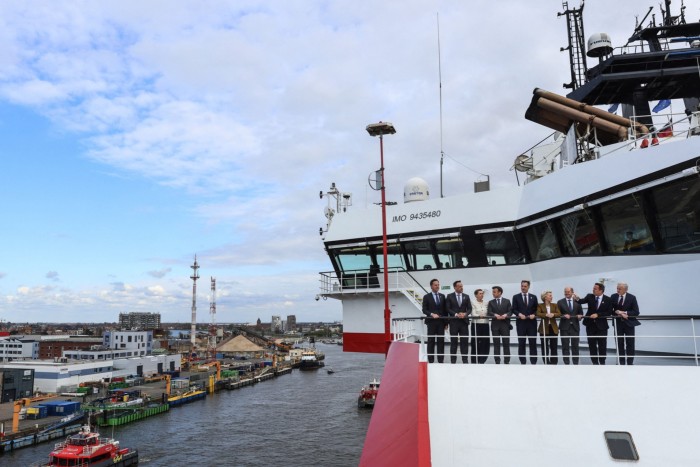Green skills shortage threatens Europe’s climate ambitions

Roula Khalaf, Editor of the FT, selects her favourite stories in this weekly newsletter.
The choppy waters of the North Sea are soon to become home to the world’s largest green energy power plant, according to a grandiose statement of intent issued by nine neighbouring countries in April.
The Ostend Declaration envisages a doubling of offshore wind capacity by 2050, powering green hydrogen production, with new interconnecting cables zipping between the UK and continental Europe.
But its heady rhetoric received a swift reality check from industry, with more than 100 companies warning that Europe does not have the capacity to deliver on these commitments. One of the biggest barriers, the industry body Wind Europe said, was the lack of skilled workers.
“Investments alone don’t manufacture blades, navigate vessels or operate wind farms,” it said. “Above all, national governments must build up the necessary skills base.”
The comments highlight one of the biggest threats to the green transition. On the one hand, fears of job losses make governments reluctant to move workers out of old industries — as seen in Germany’s opposition to a total ban on the sale of combustion engine cars from 2035.
On the other hand, severe skills and labour shortages could hobble the development of new industries and slow down urgent efforts to make homes and commercial buildings more energy-efficient.
Even as European governments fret about losing new high-tech jobs to the lure of US subsidies, the evidence suggests that they are failing to train enough workers for the more mundane tasks of fitting heat-pumps and insulation.
“People are not developing green skills at anywhere near a fast enough rate to meet climate targets,” says Sue Duke, head of global public policy for the professional network LinkedIn.
The company’s data suggests hiring for green roles has held up, both in the US and globally, against a backdrop of weakening labour markets. Sustainability analysts, specialists and managers are among the top 10 job titles for which postings have grown fastest in the past year. But the share of professionals touting profiles that mention green skills or experience has not kept pace.
Estimates of the scale of the challenge vary enormously because there is no agreed definition of what constitutes a so-called “green job”.
Some researchers count the number of people engaged in sectors that directly drive the net zero transition — such as renewable energy or electric vehicle production — and generally find the share of green jobs to be less than 5 per cent of employment in developed economies.

Others take a different approach, looking at occupations that have a high share of green-related tasks. These can be roles dedicated to green activities, such as solar panel installers. But they can also include mainstream occupations where people are increasingly taking on green tasks — such as an architect switching to more energy-efficient design — or roles such as chemists or hydrologists, which are in greater demand as a result of the green transition.
Using these more expansive definitions, some studies class a fifth of jobs or more as being “green”.
The big question, though, is whether the new jobs will be seen as good ones.
Until now, there has been a broad consensus among researchers that green jobs are both higher skilled and better paid — as well as being more likely to be occupied by men, and the more highly educated. However, a study published earlier this year by the London School of Economics’ Grantham Research Institute calls this into question. Looking at detailed data from online job postings in the US and UK, it found that low carbon jobs did indeed have higher requirements for technical, managerial and social skills than other jobs, and often called for IT skills that were in high demand in other sectors. They were not necessarily better paid, though.
In the UK, for example, large numbers of people work in green finance, pushing up the average salary for low carbon jobs in the economy, but they do not necessarily earn more than in a non-green finance role. In the US, meanwhile, an engineer working in the oil sector earns far more than in a similar engineering job elsewhere. A low carbon engineer does not command a similar wage premium.
“The real problem for these people [working in fossil fuel jobs] is that they are paid more than in green jobs, so the transition is difficult even if the skillsets are similar,” says Francesco Vona, one of the study’s authors.
Vona also says a lack of investment in reskilling workers is an obstacle to meeting governments’ targets for retrofitting homes. “For insulation and so on, they really have to learn new stuff — and the construction industry does not typically invest in on-the-job training,” he says.
Nevertheless, Anna Valero, a senior policy fellow at LSE’s Centre for Economic Performance, says wages in the green economy could soon rise rapidly in the US, due to the Biden administration’s Inflation Reduction Act stimulus package, which will drive demand for scarce skills.
European governments could learn from the approach the US has taken, offering additional tax incentives to companies that pay prevailing wages and hire apprentices, she adds. But they will also need to put more thought into mapping out career paths in sectors that are likely to see “an intense period of installation”, after which work will dial down to ongoing maintenance.
Some of this work is under way in Germany, which has long had a more structured system than most countries for vocational education. Markus Janser, a senior researcher at Germany’s Institute for Employment Research, says all courses now include content on sustainability.
However, he also points out that the green transition cannot wait on young people entering the labour market — and argues that governments should give clear incentives for companies to invest in new technologies.
“We will have no problems with skills shortages as soon as these jobs are attractive in terms of wages and working conditions . . . and if people want to go to these jobs even if they are not green at heart,” he says. “We are not in that position now.”

Comments